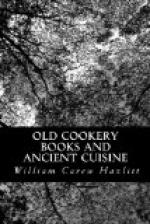Warner, however, in the “Additional Notes and Observations” to his “Antiquitates Culinariae,” 1791, expresses himself adversely to the foreign systems of cookery from an English point of view. “Notwithstanding,” he remarks, “the partiality of our countrymen to French cookery, yet that mode of disguising meat in this kingdom (except perhaps in the hottest part of the hottest season of the year) is an absurdity. It is here the art of spoiling good meat. The same art, indeed, in the South of France; where the climate is much warmer, and the flesh of the animal lean and insipid, is highly valuable; it is the art of making bad meat eatable.” At the same time, he acknowledges the superior thrift and intelligence of the French cooks, and instances the frog and the horse. “The frog is considered in this country as a disgusting animal, altogether unfit for the purposes of the kitchen; whereas, by the efforts of French cookery, the thighs of this little creature are converted into a delicate and estimable dish.” So sings, too (save the mark!), our Charles Lamb, so far back as 1822, after his visit to Paris. It seems that in Elizabeth’s reign a powdered, or pickled horse was considered a suitable dish by a French general entertaining at dinner some English officers.
It is difficult to avoid an impression that Warner has some reason, when he suggests that the immoderate use of condiments was brought to us by the dwellers under a higher temperature, and was not really demanded in such a climate as that of England, where meat can be kept sweet in ordinary seasons, much longer even than in France or in Italy. But let us bear in mind, too, how different from our own the old English cuisine was, and how many strange beasts calling for lubricants it comprehended within its range.
An edifying insight into the old Scottish cuisine among people of the better sort is afforded by Fynes Morisoh, in his description of a stay at a knight’s house in North Britain in 1598.
“Myself,” he says, “was at a knight’s house, who had many servants to attend him, that brought in his meat with their heads covered with blue caps, the table being more than half furnished with great platters of porridge, each having a little piece of sodden meat; and when the tables were served, the servants did sit down with us; but the upper mess, instead of porridge, had a pullet with some prunes in the broth. And I observed no art of cookery, or furniture of household stuff, but rather rude neglect of both, though myself and my companion, sent by the Governor of Berwick upon bordering affairs, were entertained in the best manner. The Scots ... vulgarly eat hearth-cakes of oats, but in cities have also wheaten bread, which, for the most part, was bought by courtiers, gentlemen, and the best sort of citizens. When I lived at Berwick, the Scots weekly upon the market day obtained leave in writing of the governor to buy peas and beans, whereof, as also of wheat, their merchants to this day (1617) send great quantities from London into Scotland. They drink pure wine, not with sugar, as the English, yet at feasts they put comfits in the wine, after the French manner: but they had not our vintners’ fraud to mix their wines.”




